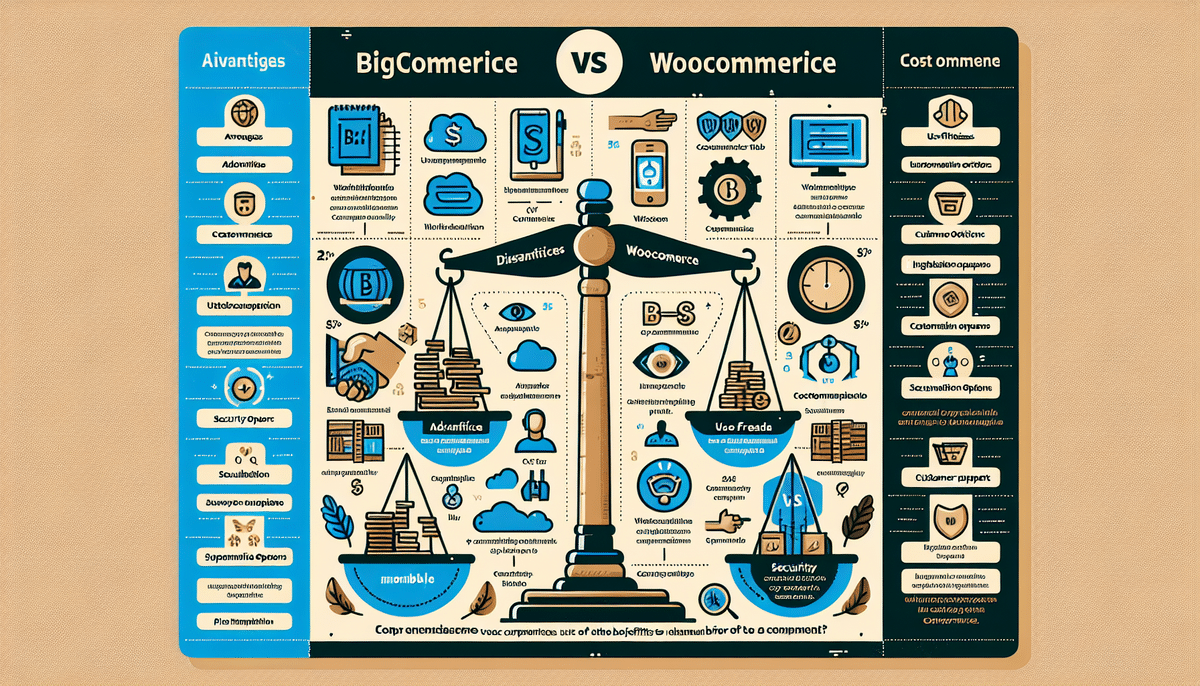Choosing the Right eCommerce Platform: WooCommerce vs PrestaShop
In today's digital age, establishing a robust online presence is essential for businesses aiming to reach a broader audience. With a multitude of eCommerce platforms available, selecting the optimal one can be challenging. This article provides an in-depth comparison of two popular platforms—WooCommerce and PrestaShop—exploring their features, pricing, usability, customization capabilities, SEO performance, security, payment and shipping integrations, customer support, and the respective pros and cons to help you determine which platform aligns best with your business objectives.
Overview of WooCommerce and PrestaShop
WooCommerce is an open-source eCommerce plugin designed for WordPress, launched in 2011. It has rapidly become one of the most widely used eCommerce solutions, thanks to its flexibility and ease of integration with WordPress websites. Being free to use, WooCommerce offers a vast ecosystem of plugins and themes developed by a large community of contributors.
PrestaShop, established in 2007, is a standalone open-source eCommerce platform available in over 60 languages. It is also free to download and use, providing a comprehensive set of features tailored for medium to large-sized businesses. PrestaShop boasts a robust marketplace for modules and themes, supported by an active developer community.
Both platforms are supported by extensive developer communities that create plugins and templates to extend their functionalities, ensuring that businesses can tailor their online stores to meet specific needs.
Key Features and Functionalities
WooCommerce Features
- Customization: Thousands of themes and plugins available for extensive customization.
- Product Management: Advanced product management features, including variable products and inventory tracking.
- Reporting: Comprehensive reporting tools to track sales, customer data, and other vital metrics.
- Integration: Seamless integration with various payment gateways, shipping providers, and marketing tools.
- Scalability: Suitable for small startups to large enterprises with extensive product catalogs.
PrestaShop Features
- Product Management: Advanced options for product customization, inventory management, and pricing strategies.
- SEO Tools: Built-in SEO features to enhance search engine rankings.
- Customization: A wide range of themes and modules available for store personalization.
- Multilingual Support: Supports multiple languages, catering to a global audience.
- Scalability: Capable of handling large inventories and high traffic volumes.
According to a Statista report, WooCommerce holds a significant market share, powering over 28% of all online stores, highlighting its popularity and reliability in the eCommerce space.
Usability and Ease of Setup
WooCommerce requires a WordPress installation, which might present a steeper learning curve for beginners unfamiliar with WordPress. However, its integration with WordPress allows users to leverage the platform's extensive content management capabilities.
PrestaShop is a standalone platform, offering a more straightforward setup process out of the box. Its user-friendly interface is designed to cater to users with varying levels of technical expertise, making it accessible for those without extensive web development experience.
While WooCommerce provides greater flexibility and customization options, PrestaShop's ease of use makes it an attractive option for businesses seeking a more streamlined setup experience.
Pricing Considerations
Both WooCommerce and PrestaShop are free to download and use. However, the total cost of ownership for each platform varies based on additional requirements:
- WooCommerce: Requires a WordPress hosting plan, which can range from $5 to $30 per month depending on the provider. Additional costs may include premium themes, plugins, and extensions to unlock advanced features.
- PrestaShop: While the core platform is free, costs arise from purchasing premium themes, modules, and securing reliable hosting services. PrestaShop also offers paid support options for businesses needing assistance.
According to a comparison by eCommerce CEO, WooCommerce can become more expensive as businesses scale and require more advanced functionalities, while PrestaShop offers a more predictable pricing structure through its modular approach.
Customization and Design Flexibility
WooCommerce benefits from the extensive WordPress ecosystem, providing access to thousands of themes and plugins. This allows businesses to create highly customized and unique online stores tailored to their specific needs.
PrestaShop also offers a diverse selection of themes and modules, though its library is not as extensive as WooCommerce's. Nonetheless, PrestaShop's modular architecture ensures that businesses can implement necessary customizations without significant hurdles.
Both platforms support custom CSS and HTML modifications, enabling developers to achieve a high level of design flexibility. However, WooCommerce's integration with WordPress provides a slight edge in terms of available resources and community support.
SEO Performance and Capabilities
Effective SEO is crucial for driving organic traffic to online stores. Both WooCommerce and PrestaShop offer built-in SEO features and support for various SEO plugins:
- WooCommerce: Leveraging WordPress's robust SEO framework, WooCommerce allows the use of powerful SEO plugins like Yoast SEO, enabling comprehensive on-page optimization, XML sitemaps, and schema markup integration.
- PrestaShop: Offers built-in SEO tools, including customizable URL structures, meta tags, and sitemaps. Additionally, PrestaShop supports various SEO modules to enhance search engine visibility.
Studies show that stores optimized with advanced SEO strategies can experience up to a 14.6% conversion rate on average, compared to 1.7% for traditional outbound methods (Search Engine Journal), highlighting the importance of robust SEO capabilities in eCommerce platforms.
Security Features and Considerations
Security is paramount in eCommerce to protect sensitive customer data and ensure trust:
- WooCommerce: Being a WordPress plugin, WooCommerce inherits WordPress's security mechanisms. It requires regular updates and the implementation of additional security measures such as SSL certificates, security plugins like Wordfence, and secure hosting environments to mitigate vulnerabilities.
- PrestaShop: Comes with built-in security features, including SSL support, secure password hashing, and protection against SQL injection and XSS attacks. PrestaShop also releases regular security updates to address potential threats.
According to Network World, implementing robust security protocols can reduce the risk of data breaches by up to 70%, underscoring the importance of thorough security measures in any eCommerce platform.
Payment and Shipping Integrations
Seamless payment and shipping integrations are critical for providing a smooth customer experience:
- Payment Gateways:
- WooCommerce: Supports a wide range of payment gateways, including PayPal, Stripe, Authorize.net, and numerous regional options. The platform's extensive plugin library allows for easy integration of additional payment methods.
- PrestaShop: Also offers numerous payment gateway options like PayPal, Stripe, and Authorize.net, with native support for several other regional and international payment providers through its module marketplace.
- Shipping Options:
- WooCommerce: Provides flexible shipping options, including flat-rate shipping, free shipping over a certain amount, and real-time shipping calculations with providers like FedEx, UPS, and USPS. Advanced shipping rules can be configured through various plugins.
- PrestaShop: Offers multiple shipping methods, such as carrier-based shipping, free shipping, and local delivery. It integrates with major carriers and allows for the creation of custom shipping rules through its modules.
Ensuring reliable and diverse payment and shipping options can significantly enhance customer satisfaction and increase conversion rates.
Customer Support and Community Resources
Effective customer support and access to community resources play a vital role in the successful management of an eCommerce store:
- WooCommerce: Benefits from a vast community of developers and users, providing extensive forums, documentation, and third-party support services. Premium support is available through various WooCommerce extension providers.
- PrestaShop: Offers comprehensive documentation, community forums, and official support channels. Businesses can also purchase dedicated support from PrestaShop experts.
According to a survey by HubSpot, 93% of customers consider customer service to be a crucial factor in their loyalty to a brand, highlighting the importance of robust support systems in eCommerce platforms.
Pros and Cons of WooCommerce and PrestaShop
Pros of Using WooCommerce
- Highly customizable with thousands of themes and plugins.
- Large and active community of developers and users.
- Built on WordPress, offering superior SEO capabilities.
- Scalable for businesses of all sizes.
Cons of Using WooCommerce
- Requires a WordPress website, adding complexity.
- Potentially higher costs due to premium plugins and themes.
- Steeper learning curve for non-technical users.
- Requires diligent security management due to its WordPress foundation.
Pros of Using PrestaShop
- Standalone platform with straightforward setup.
- Built-in security features require less additional configuration.
- Extensive multilingual and multi-currency support.
- Robust product management capabilities.
Cons of Using PrestaShop
- Less extensive library of plugins and themes compared to WooCommerce.
- Smaller developer community, potentially limiting support options.
- SEO capabilities are strong but not as flexible as WooCommerce's WordPress-based system.
- May require more technical expertise for advanced customizations.
Final Decision: Which Platform is Right for Your Business?
Both WooCommerce and PrestaShop are powerful eCommerce platforms, each with its unique strengths:
- Choose WooCommerce if: You already have a WordPress website, require extensive customization, and prioritize SEO performance.
- Choose PrestaShop if: You prefer a standalone platform with robust built-in features, require extensive multilingual support, and seek a more straightforward setup process.
Ultimately, the best choice depends on your specific business needs, technical expertise, budget, and long-term growth plans. Carefully evaluating the features, costs, and support options of each platform will guide you in selecting the eCommerce solution that best aligns with your objectives.
Conclusion
Selecting the right eCommerce platform is a pivotal decision that can significantly impact your business's online success. Both WooCommerce and PrestaShop offer comprehensive tools and features to create and manage effective online stores. By considering factors such as customization needs, ease of use, pricing, SEO capabilities, security, payment and shipping integrations, and customer support, businesses can make informed choices that drive growth and enhance customer experiences. Investing time in evaluating these platforms against your unique requirements will ensure a solid foundation for your eCommerce endeavors.






















